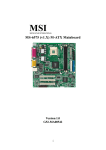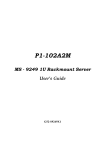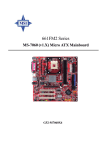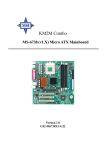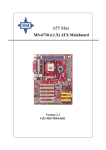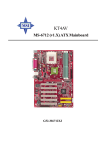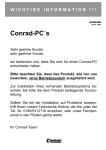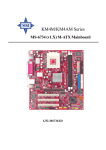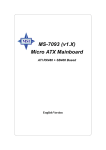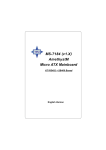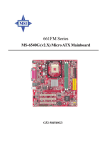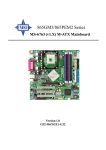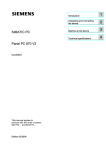Download MSI MS-6390 Instruction manual
Transcript
MS-6390 (v3.X) M-ATX Mainboard G52-M6390X2 i Manual Rev: 3.0 Release Date: February 2004 FCC-B Radio Frequency Interference Statement This equipment has been tested and found to comply with the limits for a class B digital device, pursuant to part 15 of the FCC rules. These limits are designed to provide reasonable protection against harmful interference when the equipment is operated in a commercial environment. This equipment generates, uses and can radiate radio frequency energy and, if not installed and used in accordance with the instruction manual, may cause harmful interference to radio communications. Operation of this equipment in a residential area is likely to cause harmful interference, in which case the user will be required to correct the interference at his own expense. Notice 1 The changes or modifications not expressly approved by the party responsible for compliance could void the user’s authority to operate the equipment. Notice 2 Shielded interface cables and A.C. power cord, if any, must be used in order to comply with the emission limits. VOIRLANOTICED’INSTALLATIONAVANTDERACCORDERAURESEAU. Micro-Star International MS-6390 Tested to comply with FCC Standard For Home or Office Use ii Copyright Notice The material in this document is the intellectual property of MICRO-STAR INTERNATIONAL. We take every care in the preparation of this document, but no guarantee is given as to the correctness of its contents. Our products are under continual improvement and we reserve the right to make changes without notice. Trademarks All trademarks are the properties of their respective owners. AMD, Athlon™, Athlon™ XP, Thoroughbred™, and Duron™ are registered trademarks of AMD Corporation. PS/2 and OS®/2 are registered trademarks of International Business Machines Corporation. Microsoft is a registered trademark of Microsoft Corporation. Windows® 98/ 2000/NT/XP are registered trademarks of Microsoft Corporation. NVIDIA, the NVIDIA logo, DualNet, and nForce are registered trademarks or trademarks of NVIDIA Corporation in the United States and/or other countries. Netware® is a registered trademark of Novell, Inc. Award® is a registered trademark of Phoenix Technologies Ltd. AMI® is a registered trademark of American Megatrends Inc. Revision History Revision V3.0 Revision History First release with PCB 3.0 Date February 2004 Technical Support If a problem arises with your system and no solution can be obtained from the user’s manual, please contact your place of purchase or local distributor. Alternatively, please try the following help resources for further guidance. h Visit the MSI website for FAQ, technical guide, BIOS updates, driver updates, and other information: http://www.msi.com.tw/ h Contact our technical staff at: [email protected] iii Safety Instructions 1. 2. 3. 4. 5. Always read the safety instructions carefully. Keep this User’s Manual for future reference. Keep this equipment away from humidity. Lay this equipment on a reliable flat surface before setting it up. The openings on the enclosure are for air convection hence protects the equipment from overheating. DO NOT COVER THE OPENINGS. 6. Make sure the voltage of the power source and adjust properly 110/220V before connecting the equipment to the power inlet. 7. Place the power cord such a way that people can not step on it. Do not place anything over the power cord. 8. Always Unplug the Power Cord before inserting any add-on card or module. 9. All cautions and warnings on the equipment should be noted. 10. Never pour any liquid into the opening that could damage or cause electrical shock. 11. If any of the following situations arises, get the equipment checked by a service personnel: z The power cord or plug is damaged. z Liquid has penetrated into the equipment. z The equipment has been exposed to moisture. z The equipment has not work well or you can not get it work according to User’s Manual. z The equipment has dropped and damaged. z The equipment has obvious sign of breakage. 12. DO NOT LEAVE THIS EQUIPMENT IN AN ENVIRONMENT UNCONDITIONED, STORAGE TEMPERATURE ABOVE 600 C (1400F), IT MAY DAMAGE THE EQUIPMENT. CAUTION: Danger of explosion if battery is incorrectly replaced. Replace only with the same or equivalent type recommended by the manufacturer. iv CONTENTS FCC-B Radio Frequency Interference Statement ............................................ ii Copyright Notice ........................................................................................... iii Trademarks .................................................................................................... iii Revision History ........................................................................................... iii Technical Support ......................................................................................... iii Safety Instructions ....................................................................................... v Chapter 1. Getting Started ........................................................................ 1-1 Mainboard Specifications .................................................................... 1-3 Mainboard Layout ............................................................................... 1-4 Chapter 2. Hardware Setup ....................................................................... 2-1 Quick Components Guide ..................................................................... 2-2 Central Processing Unit: CPU .............................................................. 2-3 CPU Core Speed Derivation Procedure .......................................... 2-3 CPU Installation Procedures for Socket 462 .................................. 2-4 Installing AMD Athlon CPU (Socket 462) Cooler Set .................... 2-5 Setting CPU Clock Frequency through Jumper ............................. 2-6 Memory ................................................................................................ 2-7 Introduction to DDR SDRAM ........................................................ 2-7 DIMM Module Combination ......................................................... 2-8 Installing DDR Modules ................................................................ 2-8 Power Supply ....................................................................................... 2-9 ATX 20-Pin Power Connector: CONN1 ......................................... 2-9 ATX 12V Power Connector: JPW1 ................................................ 2-9 Back Panel .......................................................................................... 2-10 Mouse/Keyboard Connector ...................................................... 2-10 USB Connectors .......................................................................... 2-11 RJ-45 LAN Jack ........................................................................... 2-11 Serial Port Connector: COM A .................................................... 2-12 VGA DB 15 Pin Connector ........................................................... 2-12 v Parallel Port Connector: LPT1 ...................................................... 2-13 Audio Port Connectors ............................................................... 2-14 Connectors ......................................................................................... 2-15 Floppy Disk Drive Connector: FDD1 ............................................ 2-15 Internal Speaker Connector: JSP1 ................................................ 2-15 Hard Disk Connectors: IDE1 & IDE2 ........................................... 2-16 Fan Power Connectors: CPUFA1/SYSFA1 .................................. 2-17 CD-In Connector: JCD1 ............................................................... 2-18 Aux Line-In Connector: JAUX1 .................................................. 2-18 Front Microphone Connector: JFMIC ......................................... 2-18 Front Panel Connector: JFP1 ....................................................... 2-19 Front USB Connector: JUSB1 ...................................................... 2-20 Jumpers .............................................................................................. 2-21 Clear CMOS Jumper: JBAT1 ........................................................ 2-21 FSB Clock Jumper: SW1 .............................................................. 2-22 Clear BIOS Password Jumper: JPWD1 ......................................... 2-23 Slots ................................................................................................... 2-24 AGP (Accelerated Graphics Port) Slot ......................................... 2-24 PCI (Peripheral Component Interconnect) Slots .......................... 2-24 PCI Interrupt Request Routing .................................................... 2-25 Chapter 3. BIOS Setup .............................................................................. 3-1 Entering Setup ...................................................................................... 3-2 Control Keys ................................................................................. 3-2 Getting Help .................................................................................. 3-3 Main ..................................................................................................... 3-4 Advanced ............................................................................................. 3-6 Power ................................................................................................. 3-10 Boot ................................................................................................... 3-11 Exit ...................................................................................................... 3-13 vi Getting Started Chapter 1. Getting Started Getting Started Thank you for purchasing the MS-6390 v3.X Micro ATX mainboard. The MS-6390 is based on VIA® KM266 & VT8235 chipsets for optimal system efficiency. Designed to fit the advanced AMD® Athlon™, Athlon™ XP or Duron™ processors, the MS-6390 delivers a high performance and professional desktop platform solution. 1-1 6390 M-ATX Mainboard MS-6390 M-ATX Mainboard Mainboard Specifications CPU h Supports Socket A (Socket-462) for AMD® Athlon™/Athlon™ XP/Duron™ processors. h Supports up to 2600+ or higher speed. Chipset h VIA® KM266 North Bridge - 200/266MHz FSB. - Integrated ProSavage8 2D/3D graphic controller. - AGP 4x and high bandwidth V-link host controller. - Advanced memory controller supports PC1600/2100 DDR. h VIA® VT8235 South Bridge - High bandwidth V-link client controller. - Direct sound ready AC97 digital audio controller. - Ultra DMA 66/100/133 master mode EIDE controller. - Supports both ACPI and legacy APM power management. - Hi-Speed USB 2.0 controller, 480Mb/sec. - Integrated Ethernet MAC. Main Memory h Supports four memory banks using two 184-pin DDR DIMMs. h Supports up to 2GB PC2100/1600 DDR SDRAMs. h Supports 2.5v DDR SDRAM. Slots h One AGP (Accelerated Graphics Port) slot. h Three 32-bit Master PCI bus slots (support 3.3v/5v PCI bus interface). On-BoardIDE h An IDE controller on the VT8235 chipset provides IDE HDD/CD-ROM with PIO, Bus Master and Ultra DMA 66/100/133 operation modes. h Can connect up to four IDE devices. On-Board Peripherals h On-Board Peripherals include: - One floppy port supports 2 FDDs with 360K, 720K, 1.2M, 1.44M and 2.88Mbytes 1-2 Getting Started - One serial port (COM A) - One VGA port - One parallel port supports SPP/EPP/ECP mode - One RJ-45 LAN port - Vertical audio ports - One 3-pin internal speaker connector - Six USB 2.0 ports (Rear * 4/ Front * 2) Audio h 5.1 channel AC’97 software audio integrated on VT8235 south bridge. h RealTek ALC650 6-channel audio. LAN h VIA® VT8235 integrated MAC + VT6103 PHY. BIOS h The mainboard BIOS provides “Plug & Play” BIOS which detects the peripheral devices and expansion cards of the board automatically. h The mainboard provides a Desktop Management Interface (DMI) function which records your mainboard specifications. Dimension h Micro ATX Form Factor: 24.5cm x 21.7cm. Mounting h 6 mounting holes. 1-3 6390 M-ATX Mainboard MS-6390 M-ATX Mainboard Mainboard Layout Top: Mouse Bottom: Keyboard CONN1 JPW1 SOCKET 462 USB Ports Winbond 83697HF BIOS CPUFA1 FDD1 Top: LPT Bottom: COM A VGA Port VIA KM266 T: RJ45 LAN Jack B: USB Ports SYSFA1 Line-In Line-Out Mic IDE 1 IDE 2 DIMM1 PCI Slot 1 DIMM2 AGP Slot VIA VT6103 JSP1 PCI Slot 2 VT8235 Codec JBAT1 JCD1 BATT + JFMIC JAUX1 JFP1 JUSB1 MS-6390 v3.X Micro ATX Mainboard 1-4 JPWD1 PCI Slot 3 SW1 Hardware Setup Chapter 2. Hardware Setup Hardware Setup This chapter provides you with the information about hardware setup procedures. While doing the installation, be careful in holding the components and follow the installation procedures. For some components, if you install in the wrong orientation, the components will not work properly. Use a grounded wrist strap before handling computer components. Static electricity may damage the components. 2-1 MS-6390 M-ATX Mainboard 6390 M-ATX Mainboard Quick Components Guide CPU, p.2-3 CONN1, p.2-9 CPUFA1, p.2-17 DIMM1/2, p.2-7 JPW1, p.2-9 Back Panel I/O, p.2-10 FDD1, p.2-15 SYSFA1, p.2-17 AGP Slot, p.2-24 JSP1, p.2-15 JCD1, p.2-18 JAUX1, p.2-18 IDE1/2, p.2-16 PCI Slots, p.2-24 JPWD1, p.2-23 JBAT1, p.2-21 SW1, p.2-22 JFP1, p.2-19 JFMIC, p.2-18 JUSB1, p.2-20 2-2 Hardware Setup Central Processing Unit: CPU The mainboard supports AMD® Athlon™, Athlon™ XP and Duron™ processors in the 462 pin package. The mainboard uses a CPU socket called Socket A for easy CPU installation. When you are installing the CPU, make sure the CPU has a heat sink and a cooling fan attached on the top to prevent overheating. If you do not find the heat sink and cooling fan, contact your dealer to purchase and install them before turning on the computer. CPU Core Speed Derivation Procedure If CPU Clock Core/Bus ratio then CPU core speed WARNING! = = = = = 100MHz 14 Host Clock x Core/Bus ratio 100MHz x 14 1.4GHz Thermal Issue for CPU As processor technology pushes to faster speeds and higher performance, thermal management becomes increasingly crucial when building computer systems. Maintaining the proper thermal environment is key to reliable operation. As such, the processor must be maintained in the specified thermal requirements. AMD Athlon™/Duron™/Athlon™ XP processor with a speed of 600MHz and above requires a LARGER heatsink and fan. You also need to add thermal grease between the CPU and heatsink to improve heat dissipation. Then, make sure that the CPU and heatsink are securely fastened and in good contact with each other. These are needed to prevent damaging the processor and ensuring reliable operation. If you want to get more information on the proper cooling, you can visit AMD’s website for reference. 2-3 MS-6390 M-ATX Mainboard 6390 M-ATX Mainboard CPU Installation Procedures for Socket 462 1. Please turn off the power and unplug the power cord before installing the CPU. Open Lever Sliding Plate 90 degree 2. Pull the lever sideways away from the socket. Make sure to raise the lever up to a 90degree angle. Gold arrow 3. Look for the gold arrow. The gold arrow should point towards the lever pivot. The CPU can only fit in the correct orientation. 4. If the CPU is correctly installed, the pins should be completely embedded into the socket and can not be seen. Please note that any violation of the correct installation procedures may cause permanent damages to your mainboard. 5. Press the CPU down firmly into the socket and close the lever. As the CPU is likely to move while the lever is being closed, always close the lever with your fingers pressing tightly on top of the CPU to make sure the CPU is properly and completely embedded into the socket. 2-4 Gold arrow Correct CPU placement O Gold arrow Incorrect CPU placement X Press down the CPU Close Lever Hardware Setup Installing AMD Athlon CPU (Socket 462) Cooler Set The following instructions will guide you through the heat sink installation procedures. Please consult your agent for the proper CPU cooler set. 1. Position your CPU cooler set onto the CPU. Apply some heat sink paste 2. Use one end of the clip to hook the latch of the CPU sliding plate. 3. Hook the other latch to fix the cooling fan set. You may need a screw drive to press down the other side of the clip. 4. Connect the fan to the fan power connector provided on your mainboard. NOTE: Please apply some heat sink paste on top of CPU to dissipate the heat more effectively. 2-5 MS-6390 M-ATX Mainboard 6390 M-ATX Mainboard Setting CPU Clock Frequency through Jumper The hardware configuration for CPU clock frequency of the motherboard is set to 133MHz by default. Therefore, to make a 100MHz CPU run at 100MHz when it is installed on the board, you have to adjust the CPU clock frequency through jumper. To set the clock frequency of the installed CPU, refer to Jumpers/FSB Clock Jumper: SW1 in later section of this chapter. NOTE: Overheating Overheating will seriously damage the CPU and system, always make sure the cooling fan can work properly to protect the CPU from overheating. Replacing the CPU While replacing the CPU, always turn off the ATX power supply or unplug the power supply’s power cord from grounded outlet first to ensure the safety of CPU. Overclocking This motherboard is designed to support overclocking. However, please make sure your components are able to tolerate such abnormal setting, while doing overclocking. Any attempt to operate beyond product specifications is not recommended. We do not guarantee the damages or risks caused by inadequate operation or beyond product specifications. 2-6 Hardware Setup Memory The mainboard provides 2 slots for 184-pin DDR SDRAM DIMM (Double In-Line Memory Module) modules and supports the memory size up to 2GB. You can install PC2100/DDR266 or PC1600/DDR200 modules on the DDR DIMM slots (DIMM 1~2). DDR DIMM Slots (DIMM 1~2) Introduction to DDR SDRAM DDR (Double Data Rate) SDRAM is similar to conventional SDRAM, but doubles the rate by transferring data twice per cycle. It uses 2.5 volts as opposed to 3.3 volts used in SDR SDRAM, and requires 184-pin DIMM modules rather than 168-pin DIMM modules used by SDR SDRAM. High memory bandwidth makes DDR an ideal solution for high performance PC, workstations and servers. 2-7 MS-6390 M-ATX Mainboard 6390 M-ATX Mainboard DIMM Module Combination Install at least one DIMM module on the slots. Memory modules can be installed on the slots in any order. You can install either single- or double-sided modules to meet your own needs. Memory modules can be installed in any combination as follows: Slot Memory Module Total Memory DIMM 1 (Bank 0 & 1) DIMM 2 (Bank 2 & 3) S/D 64MB~1GB S/D 64MB~1GB Maximum System Memory Supported 64MB~2GB S: Single Side D: Double Side Installing DDR Modules 1. The DDR DIMM has only one notch on the center of module. The module will only fit in the right orientation. 2. Insert the DIMM memory module vertically into the DIMM slot. Then push it in until the golden finger on the memory module is deeply inserted in the socket. NOTE: You can barely see the golden finger if the module is properly inserted in the socket. 3. The plastic clip at each side of the DIMM slot will automatically close. Volt 2-8 Notch Hardware Setup Power Supply The mainboard supports ATX power supply for the power system. Before inserting the power supply connector, always make sure that all components are installed properly to ensure that no damage will be caused. ATX 20-Pin Power Connector: CONN1 This connector allows you to connect to an ATX power supply. To connect to the ATX power supply, make sure the plug of the power supply is inserted in the proper orientation and the pins are aligned. Then push down the power supply firmly into the connector. ATX 12V Power Connector: JPW1 This 12V power connector is used to provide power to the CPU. 11 1 20 10 CONN1 JPW1 2 1 4 3 CONN1 Pin Definition JPW1 Pin Definition PIN SIGNAL 1 2 3 4 GND GND 12V 12V PIN SIGNAL PIN SIGNAL 1 2 3 4 5 6 7 8 9 3.3V 3.3V GND 5V GND 5V GND PW_OK 5V_SB 10 12V 11 12 13 14 15 16 17 18 19 20 3.3V -12V GND PS_ON GND GND GND -5V 5V 5V 2-9 MS-6390 M-ATX Mainboard 6390 M-ATX Mainboard Back Panel The back panel provides the following connectors: Parallel Mouse LAN L-In L-Out MIC Keyboard USB COM A VGA USB Mouse/Keyboard Connector The mainboard provides a standard PS/2® mouse/keyboard mini DIN connector for attaching a PS/2® mouse/keyboard. You can plug a PS/2® mouse/ keyboard directly into this connector. The connector location and pin assignments are as follows: Pin Definition 6 5 3 4 2 1 PS/2 Mouse/Keyboard (6-pin Female) 2-10 PIN SIGNAL DESCRIPTION 1 2 3 4 5 6 Mouse/Keyboard Data NC GND VCC Mouse/Keyboard Clock NC Mouse/Keyboard data No connection Ground +5V Mouse/Keyboard clock No connection Hardware Setup USB Connectors The mainboard provides four UHCI (Universal Host Controller Interface) Universal Serial Bus roots for attaching USB devices such as keyboard, mouse or other USB-compatible devices. You can plug USB devices directly into the connectors. Pin Definition 1 2 3 4 USB Ports PIN SIGNAL DESCRIPTION 1 2 VCC -Data 0 +5V Negative Data Channel 0 3 4 +Data0 GND Positive Data Channel 0 Ground RJ-45 LAN Jack The mainboard provides one standard RJ-45 jack for connection to Local Area Network (LAN). You can connect a network cable to the LAN jack. Activity Indicator Speed Indicator Pin Definition 8 1 RJ-45 LAN Jack PIN SIGNAL DESCRIPTION 1 TDP Transmit Differential Pair 2 TDN Transmit Differential Pair 3 RDP Receive Differential Pair 4 NC Not Used 5 NC Not Used 6 RDN Receive Differential Pair 7 NC Not Used 8 NC Not Used 2-11 MS-6390 M-ATX Mainboard 6390 M-ATX Mainboard Serial Port Connector: COM A The mainboard provides one 9-pin serial port connector COM A. This port is a 16550A high speed communication port that sends/receives 16 bytes FIFOs. You can attach a serial mouse or other serial devices directly to the connector. Pin Definition COM A 1 2 3 4 5 6 7 8 9 PIN SIGNAL DESCRIPTION 1 2 3 4 5 6 7 8 9 DCD SIN SOUT DTR GND DSR RTS CTS RI Data Carry Detect Serial In or Receive Data Serial Out or Transmit Data Data Terminal Ready Ground Data Set Ready Request To Send Clear To Send Ring Indicate VGA DB 15 Pin Connector One DB 15-pin VGA connector is provided for connection to a VGA monitor. Pin Definition Analog Video Display Connector (DB-15S) PIN SIGNAL DESCRIPTION 5 15 1 11 DB 15-Pin Female Connector 2-12 1 2 3 4 5 6 7 8 9 10 11 12 13 14 15 Red Green Blue Not used Ground Ground Ground Ground Power Ground Not used SDA Horizontal Sync Vertical Sync SCL Hardware Setup Parallel Port Connector: LPT1 The mainboard provides a 25-pin female centronic connector as LPT. A parallel port is a standard printer port that supports Enhanced Parallel Port (EPP) and Extended Capabilities Parallel Port (ECP) mode. 13 1 14 25 Pin Definition PIN SIGNAL DESCRIPTION 1 2 3 4 5 6 7 8 9 10 11 12 13 14 15 16 17 18 19 20 21 22 23 24 25 STROBE DATA0 DATA1 DATA2 DATA3 DATA4 DATA5 DATA6 DATA7 ACK# BUSY PE SELECT AUTO FEED# ERR# INIT# SLIN# GND GND GND GND GND GND GND GND Strobe Data0 Data1 Data2 Data3 Data4 Data5 Data6 Data7 Acknowledge Busy Paper End Select Automatic Feed Error Initialize Printer Select In Ground Ground Ground Ground Ground Ground Ground Ground 2-13 MS-6390 M-ATX Mainboard 6390 M-ATX Mainboard Audio Port Connectors Line Out is a connector for Speakers or Headphones. Line In is used for external CD player, Tape player, or other audio devices. Mic is a connector for microphones. 1/8” Stereo Audio Connectors Line In Line Out MIC 2-14 Hardware Setup Connectors The mainboard provides connectors to connect to FDD, IDE HDD, case, modem, LAN, USB Ports, IR module and CPU/System/Power Supply FAN. Floppy Disk Drive Connector: FDD1 The mainboard provides a standard floppy disk drive connector that supports 360K, 720K, 1.2M, 1.44M and 2.88M floppy disk types. FDD1 Internal Speaker Connector: JSP1 This connector is used to connect the internal speaker if available. JSP1 SPKR GND SPKL 2-15 MS-6390 M-ATX Mainboard 6390 M-ATX Mainboard Hard Disk Connectors: IDE1 & IDE2 IDE2 IDE1 The mainboard has a 32-bit Enhanced PCI IDE and Ultra ATA 66/100 controller that provides PIO mode 0~4, Bus Master, and Ultra ATA 66/100 function. You can connect up to four hard disk drives, CD-ROM, 120MB Floppy (reserved for future BIOS) and other devices. IDE1 (Primary IDE Connector) The first hard drive should always be connected to IDE1. IDE1 can connect a Master and a Slave drive. You must configure second hard drive to Slave mode by setting the jumper accordingly. IDE2 (Secondary IDE Connector) IDE2 can also connect a Master and a Slave drive. NOTE: If you install two hard disks on cable, you must configure the second drive to Slave mode by setting its jumper. Refer to the hard disk documentation supplied by hard disk vendors for jumper setting instructions. 2-16 Hardware Setup Fan Power Connectors: CPUFA1/SYSFA1 The CPUFA1 (processor fan) and SYSFA1 (system fan) support system cooling fan with +12V. It supports three-pin head connector. When connecting the wire to the connectors, always take note that the red wire is the positive and should be connected to the +12V, the black wire is Ground and should be connected to GND. SENSOR +12V GND CPUFA1 SENSOR +12V GND SYSFA1 NOTE: Always consult the vendors for proper CPU cooling fan. 2-17 MS-6390 M-ATX Mainboard 6390 M-ATX Mainboard CD-In Connector: JCD1 The connector is for CD-ROM audio connector. Aux Line-In Connector: JAUX1 The connector is for DVD add-on card with Line-in connector. Front Microphone Connector: JFMIC This connector is used to connect the front panel microphone if available. JCD1 R GND L JFMIC JAUX1 3 R 1 GND L JFMIC Pin Definition 2-18 PIN SIGNAL DESCRIPTION 1 2 3 FMIC GND VCC Front Microphone Ground VCC5V Hardware Setup Front Panel Connector: JFP1 The mainboard provides one front panel connector for electrical connection to the front panel switches and LEDs. The JFP1 is compliant with Intel® Front Panel I/O Connectivity Design Guide. Power Power LED Switch JFP1 2 1 10 9 HDD Reset LED Switch JFP1 Pin Definition PIN SIGNAL DESCRIPTION 1 2 3 4 5 6 7 8 9 HD_LED_P FP PWR/SLP HD_LED_N FP PWR/SLP RST_SW_N PWR_SW_P RST_SW_P PWR_SW_N RSVD_DNU Hard disk LED pull-up MSG LED pull-up Hard disk active LED MSG LED pull-up Reset Switch low reference pull-down to GND Power Switch high reference pull-up Reset Switch high reference pull-up Power Switch low reference pull-down to GND Reserved. Do not use. 2-19 MS-6390 M-ATX Mainboard 6390 M-ATX Mainboard Front USB Connector: JUSB1 The mainboard provides one USB 2.0 pin header JUSB1 (optional USB 2. 0 bracket available) that is compliant with Intel® I/O Connectivity Design Guide. USB 2.0 technology increases data transfer rate up to a maximum throughput of 480Mbps, which is 40 times faster than USB 1.1, and is ideal for connecting high-speed USB interface peripherals such as USB HDD, digital cameras, MP3 players, printers, modems and the like. 1 2 9 10 JUSB1 Pin Definition 2-20 PIN SIGNAL PIN SIGNAL 1 USBPWR 2 USBPWR 3 USBP4- 4 USBP5- 5 USBP4+ 6 USBP5+ 7 GND 8 GND 9 NC 10 USBOC Hardware Setup Jumpers The motherboard provides the following jumpers for you to set the computer’s function. This section will explain how to change your motherboard’s function through the use of jumpers. Clear CMOS Jumper: JBAT1 There is a CMOS RAM on board that has a power supply from external battery to keep the data of system configuration. With the CMOS RAM, the system can automatically boot OS every time it is turned on. If you want to clear the system configuration, use the JBAT1 (Clear CMOS Jumper ) to clear data. Follow the instructions below to clear the data: 1 JBAT1 1 3 Keep Data 3 1 Clear Data NOTE: To clear CMOS, first make pin #2-3 short connected after the system is off. And then power on the system and short connect pin #1-2 before entering the BIOS (Standard CMOS Features) to clear data. 2-21 MS-6390 M-ATX Mainboard 6390 M-ATX Mainboard FSB Clock Jumper: SW1 These two jumpers provide 100MHz and 133MHz Front Side Bus frequency selection for overclocking purpose. 1 SW1 1 3 FSB = 100MHz 2-22 1 3 FSB = 133MHz Hardware Setup Clear BIOS Password Jumper: JPWD1 The jumper is used to clear the BIOS password. To clear the password, open the jumper and restart your computer. JPWD1 Clear Normal 2-23 MS-6390 M-ATX Mainboard 6390 M-ATX Mainboard Slots The motherboard provides one AGP slot and three 32-bit Master PCI bus slots. AGP Slot PCI Slots AGP (Accelerated Graphics Port) Slot The AGP slot allows you to insert the AGP graphics card. AGP is an interface specification designed for the throughput demands of 3D graphics. It introduces a 66MHz, 32-bit channel for the graphics controller to directly access main memory. PCI (Peripheral Component Interconnect) Slots The PCI slots allow you to insert the expansion cards to meet your needs. When adding or removing expansion cards, make sure that you unplug the power supply first. Meanwhile, read the documentation for the expansion card to make any necessary hardware or software settings for the expansion card, such as jumpers, switches or BIOS configuration. 2-24 Hardware Setup PCI Interrupt Request Routing The IRQ, acronym of interrupt request line and pronounced I-R-Q, are hardware lines over which devices can send interrupt signals to the microprocessor. The PCI IRQ pins are typically connected to the PCI bus INT A# ~ INT D# pins as follows: Order 1 Order 2 Order 3 Order 4 PCI Slot 1 INT A# INT B# INT C# INT D# PCI Slot 2 INT B# INT C# INT D# INT A# PCI Slot 3 INT C# INT D# INT A# INT B# 2-25 BIOS Setup Chapter 3. BIOS Setup BIOS Setup This chapter provides information on the BIOS Setup program and allows you to configure the system for optimum use. You may need to run the Setup program when: An error message appears on the screen during the system booting up, and requests you to run SETUP. You want to change the default settings for customized features. 3-1 6390 M-ATX Mainboard Entering Setup Power on the computer and the system will start POST (Power On Self Test) process. Press <F1> to enter the BIOS Setup. If you fail to press <F1> and the system enters to the Windows OS and you still wish to enter Setup, restart the system by turning it OFF and On or pressing the RESET button. You may also restart the system by simultaneously pressing <Ctrl>, <Alt>, and <Delete> keys. Control Keys <↑> <↓> <←> <→> <Enter> <Esc> <+/PU> <-/PD> <F1> <F5> <F10> 3-2 Move to the previous item Move to the next item Move to the item in the left hand Move to the item in the right hand Select the item Jumps to the Exit menu or returns to the main menu from a submenu Increase the numeric value or make changes Decrease the numeric value or make changes General help, only for Status Page Setup Menu and Option Page Setup Menu Reload Defaults Save all the CMOS changes and exit BIOS Setup Getting Help After entering the Setup menu, the first menu you will see is the Main Menu. Main Menu The main menu lists the setup functions you can make changes to. You can use the arrow keys ( ↑↓ ) to select the item. The on-line description of the highlighted setup function is displayed at the bottom of the screen. Sub-Menu If you find a right pointer symbol (as shown in the right view) appears to the left of certain fields that means a submenu can be launched from this field. A sub-menu contains additional options for a field parameter. You can use arrow keys ( ↑↓ ) to highlight the field and press <Enter> to call up the sub-menu. Then you can use the control keys to enter values and move from field to field within a submenu. If you want to return to the main menu, just press the <Esc >. General Help <F1> The BIOS setup program provides a General Help screen. You can call up this screen from any menu by simply pressing <F1>. The Help screen lists the appropriate keys to use and the possible selections for the highlighted item. Press <Esc> to exit the Help screen. NOTE: The items under each BIOS category described in this chapter are under continuous update for better system performance. Therefore, the description may be slightly different from the latest BIOS and should be held for reference only. 3-3 6390 M-ATX Mainboard Main Once you enter Phoenix-Award® BIOS CMOS Setup Utility, the Main menu will appear on the screen. The Main menu allows you to select some basic information about the system. Use arrow keys to select among the items and press <Enter> to accept or enter the sub-menu. System Date This allows you to set the system to the date that you want (usually the current date). The format is <day><month> <date> <year>. day Day of the week, from Sun to Sat, determined by BIOS. Read-only. month The month from Jan. through Dec. date The date from 1 to 31 can be keyed by numeric function keys. year The year can be adjusted by users. System Time This allows you to set the system time that you want (usually the current time). The time format is <hour> <minute> <second>. Language This item allows you to select the BIOS language. 3-4 BIOS Setup Floppy Diskette A This item allows you to set the type of floppy drives installed. Available options: Disabled, 720K, 3.5 in., 1.44M, 3.5 in., 2.88M, 3.5 in. Primary/Secondary Master/Slave Press PgUp/<+> or PgDn/<-> to select Manual, None or Auto type. Note that the specifications of your drive must match with the drive table. The hard disk will not work properly if you enter improper information for this category. If your hard disk drive type is not matched or listed, you can use Manual to define your own drive type manually. Installed Memory / Memory Slot 1 / Memory Slot 2 These items show the memory status of your system (read only). BIOS Core Version / BIOS Revision These items show the BIOS status of your system (read only). 3-5 6390 M-ATX Mainboard Advanced CPU Type / CPU Speed / CPU Cache RAM These items show the related information of CPU. (read-only) Plug and Play Aware O/S When set to Yes, BIOS will only initialize the PnP cards used for booting (VGA, IDE, SCSI). The rest of the cards will be initialized by the PnP operating system like Windows 98, 2000 or ME. When set to No, BIOS will initialize all the PnP cards. Select Yes if the operating system is Plug & Play. Reset ESCD Normally, you leave this field No. Select Yes to reset Extended System Configuration Data (ESCD) when you exit Setup if you have installed a new addon and the system reconfiguration has caused such a serious conflict that the operating system cannot boot. Onboard Video Memory The item is to set the onboard video memory. Settings: 8M, 16M, 32M. Primary Video Adapter This item specifies which VGA card is your primary graphics adapter. Settings: PCI and AGP Onboard. 3-6 BIOS Setup PS/2 Mouse If your system has a PS/2 mouse port and you install a serial pointing device, select Disabled. Setting options: Auto Detected, Disabled, Enabled. Local Bus IDE Adapter The chipset contains a PCI IDE interface with support for two IDE channels. Select Primary to activate the only primary IDE interface, if you install an addin secondary interface. Select Both to activate both interfaces, or Disabled to deactivate both interfaces, if you install both a primary and a secondary addin IDE interface. Setting options: Both, Disabled, Primary, Secondary. USB Legacy Mode Support Set to Enabled if your need to use any USB 1.1/2.0 device in the operating system that does not support or have any USB 1.1/2.0 driver installed, such as DOS and SCO Unix. Set to Disabled only if you want to use any USB device other than the USB mouse. Setting options: Disabled, Enabled. Onboard LAN This setting controls the onboard LAN controller. Setting options: Disabled, Enabled. Set Supervisor Password The items allow you to set the password of the supervisor. With this password, one can enter and change the settings of the setup menu. Press <Enter> to change the password, then press <Enter> again if you want to disable the password. Set User Password The items allow you to set the password of the user. With this password, one can only enter but do not have the right to change the settings of the setup menu. 3-7 6390 M-ATX Mainboard I/O device Configuration Press <Enter> to enter the sub-menu screen. Serial Port Setting to Enabled to use the serial port. Setting options: Enabled, Disabled. Base Address/Interrupt This item is to select an address and corresponding address/interrupt for the first and second serial ports, and it is available only when Serial Port is set to Enabled. The settings are: 3F8/IRQ4, 2E8/ IRQ3, 3E8/IRQ4, 2F8/IRQ3, Disabled, Auto. Parallel Port Setting to Enabled to use the parallel port. Setting options: Enabled, Disabled. Base Address/Interrupt This item is to select an address and corresponding address/interrupt for the onboard parallel port, and it is available only when Parallel Port is set to Enabled. The settings are: 378/IRQ7, 278/IRQ5, 3BC/IRQ7. Mode This item selects the operation mode for the onboard parallel port. Settings: ECP, Bi-directional. 3-8 BIOS Setup On-Board Audio Options Press <Enter> to enter the sub-menu screen. Codec This item is used to enable or disable the onboard AC’97 (Audio Codec’97) feature. Selecting Auto allows the mainboard to detect whether an audio device is used. If an audio device is detected, the onboard AC’97 controller will be enabled; if not, the controller is disabled. Disable the function if you want to use other controller cards to connect an audio device. Settings: Enabled, Disabled and Auto. HardWare Monitor Press <Enter> to enter the sub-menu screen. CPU/System Fan Speed, CPU/System Temperature These items display the current status of all of the monitored hardware devices/components such as CPU temperatures and all fans’ speeds. 3-9 6390 M-ATX Mainboard Power After AC Power Failure This setting specifies whether your system will reboot after a power failure or interrupt occurs. Available settings are: Stay Off Leaves the computer in the power off state. Power On Leaves the computer in the power on state. Auto Restores the system to the previous status before power failure or interrupt occurred. 3-10 BIOS Setup Boot Quick Boot Mode Setting the item to Enabled allows the system to boot within 5 seconds since it will skip some check items. Available options: Enabled, Disabled. Boot Device Priority Press <Enter> to enter the sub-menu and the following screen appears: Boot Device Priority: 1st/2nd/3rd/4th The items allow you to set the sequence of boot devices where BIOS attempts to load the disk operating system. 3-11 6390 M-ATX Mainboard MSI Reminds You... Available settings for “1st/2nd/3rd/4th Boot Device” vary depending on the bootable devices you have installed. For example, if you did not install a floppy drive, the setting “Floppy” does not show up. Hark Disk Boot Priority Press <Enter> to enter the sub-menu and the following screen appears: Here it shows the bootable add-in cards like IDE cards and SCSI cards... etc. Read-only. 3-12 BIOS Setup Exit Exit Saving Changes / Exit Discarding Changes / Load Setup Default / Discard Changes / Save Changes You may choose one of these options before leaving the BIOS setup utility. Exit Saving Change Exit System Setup utility and saves your changes to CMOS. Exit Discarding Changes Exit System Setup utility without saving setup data to CMOS. Load Setup Default Load the default values for all the setup items. Discard Changes Load previous values from CMOS for all setup items. Save Changes Save Setup Datas to CMOS. 3-13

















































